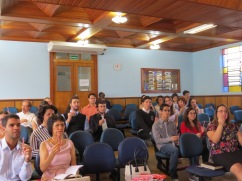If you love pizza, you won’t be disappointed in São Paulo. There are all sorts of good to great pizzas and prices in every neighborhood. This time of year many São Paulo restaurants close down but if you’re patient you’ll find a good option.
Last night we had scheduled to meet dear friends at Camelo Pizzaria in Itaim but when we got there it was closed, so we called and found out that Veridiana Jardins was open at regular hours.
We’ve been to Veridiana Pizzaria in Jardins many times, one of the reasons: the pizza is usually really good and light. The second reason: It’s just down the street from our  home. The place is really welcoming, with a lovely front garden and beautiful trees, high ceilings, good lighting, a gorgeous glass floor showing the wine cellar and a grand piano (which needs to be tuned, by the way). Talking about music, last night, a lady pianist was doing her best but the music you play in a noisy environment with 200+ people talking and laughing, must flow and not clash with the surrounding sound. I learned this from our dear pianist friend, Richard O. Kogima. Conclusion: the music was more like a car crash but that’s ok, because we had a table (after a 40 minute wait at the bar) in the front garden, outdoors- fortunately a quieter place.
home. The place is really welcoming, with a lovely front garden and beautiful trees, high ceilings, good lighting, a gorgeous glass floor showing the wine cellar and a grand piano (which needs to be tuned, by the way). Talking about music, last night, a lady pianist was doing her best but the music you play in a noisy environment with 200+ people talking and laughing, must flow and not clash with the surrounding sound. I learned this from our dear pianist friend, Richard O. Kogima. Conclusion: the music was more like a car crash but that’s ok, because we had a table (after a 40 minute wait at the bar) in the front garden, outdoors- fortunately a quieter place.
Despite the wait, the waiter tried to do his best, but the restaurant’s electronic ordering system was freezing all the time. We had to repeat 3 times just what we were drinking. When we ordered the pizzas he asked the kind of crust  we wanted: thin, medium or thick, with or without borders. We wanted to order one pizza with a thin crust and another with a medium crust. The waiter who was rushing to and fro, said he’d already entered “thin crust” and there was no way to change that, otherwise he would have to cancel the entire order which had already taken some 15 minutes and start all over again. so, thin crust it was.
we wanted: thin, medium or thick, with or without borders. We wanted to order one pizza with a thin crust and another with a medium crust. The waiter who was rushing to and fro, said he’d already entered “thin crust” and there was no way to change that, otherwise he would have to cancel the entire order which had already taken some 15 minutes and start all over again. so, thin crust it was.
Veridiana prides itself in the originality of its pizzas so no chicken with catupiry cheese, corn with catupiry cheese are on their menu. These 2 are traditional favorites by “Paulistanos”. They have fried zucchini with ricotta cheese, heart of palm and garlic with tomato sauce (no cheese). You get the gist right?
Last night the pizzas took so long to come and despite the hot weather – they were not hot – lukewarm at best. Honest to God, the heart of palm was hard and their “original” margherita pizza was tasteless.
To get the check was another way of sorrows – no waiter around. We had to hunt the manager inside. When the check finally came it was wrong -in addition to the drinks and pizzas they had charged us for peperroni snacks and beer – which we hadn’t either eaten or drunk.
Finally we asked the waiter why such a lame service – not in those words, of course, and he said half of the staff hadn’t showed up. So there were only 5 waiters to take care of more than 200 PAYING guests.
Would I recommend this pizzeria? Hell, yes. Because of its location and nice ambiance. For the quality of the pizza and service. No.







































